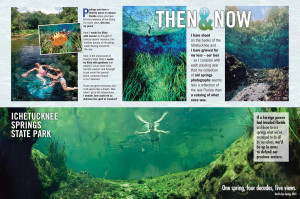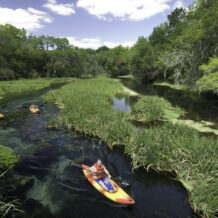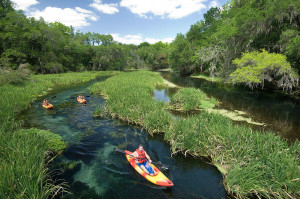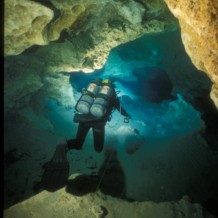health and science
Ichetucknee Springs
Like all rivers, Ichetucknee relies on two basic things for its existence; a reliable source of water and minimal pollution. For Ichetucknee River and the other spring-fed rivers of North Florida, meeting those needs comes with unique challenges. Fed by the vast and largely unknown underground reservoir of the Floridan Aquifer, measuring the available water supply and tracking sources of pollutants for these rivers is a daunting task.
The earliest measurements of water quality on Ichetucknee were made in 1946. Since then, a growing volume of data has been collected by private and government agencies as well as university students for research projects. The majority of the early data came from observations and measurements taken from surface water of the springs and the river. The primary access to the underground water was through wells.
In the last few decades, that effort has expanded to include first-hand observations of the underground component of the Ichetucknee system. With the advent of SCUBA and the efforts of a dedicated group of local, world-class cave divers, our understanding of the aquifer systems has grown exponentially.
On August 15, 1997, cave divers entered a water-filled sink hole (technically called a “swallet”) in the bed of a stream that flows through Lake City. After travelling nearly 700 feet along the winding passageways, at a depth of 140 feet below the water table, they pulled out a small container and released 20 pounds of flourescein dye. A veil of neon-green mist swirled briefly and then drifted away into the darkness.
For the next month, volunteers collected water samples from 14 monitoring stations throughout the Ichetucknee River basin. Most of these stations were wells and springs. Twelve days later, traces of the flourescein were detected in the water at Mission Springs. In the following days it appeared in several other springs along Ichetucknee River.
This study proved what had long been suspected; that some of the water running off of the streets and yards of Lake City makes its way into the aquifer and eventually the springs of Ichetucknee River. And with that water comes everything that spills onto the ground in Lake City including chemicals, pesticides and, perhaps most significantly, nitrate nitrogen which comes from fertilizers and animal waste.
Nitrogen is found throughout all healthy ecosystems; in the soil, in the water and even in the air. It’s a vital nutrient that sustains plants and animals in life. Animals release it in their waste and when they die, it is released from their bodies by decomposition. It is then used to sustain other plants and animals. Nitrate-nitrogen is part of a finely-tuned cycle. But too much of it is harmful to the system. It promotes excessive plant growth which, in turn, uses too much oxygen. And when there’s not enough oxygen in the water, the entire system suffers—plants and animals alike.
These days, excess nitrate-nitrogen is the greatest form of contamination affecting Ichetucknee. An excellent analysis of this and other threats to the Ichetucknee, complete with diagrams, facts and figures, can be found in the Ichetucknee Springs Restoration Plan (ISRP) prepared in 2012 by The Florida Springs Institute, under the leadership of Dr. Robert Knight. In a 2009 study cited in the ISRP, it was estimated that “nitrogen inputs to the groundwater in the (Ichetucknee) basin to be between 262,000 kg/yr and 1.3 million kg/yr (289 to 1,430 tons/yr); the wide range is due to the high uncertainty in calculating nitrogen loss.” (Florida Springs Institute’s Ichetucknee Restoration Plan, pg. 82)

Panel from John Moran’s exhibition Springs Eternal: Florida’s Fragile Fountains of Youth, at the Florida Museum of Natural History through December 15th 2013.
But, nothing tells the story like photos. In 1999, a report prepared by the State of Florida stated that “Ichetucknee River is perhaps the most pristine waterway in the United States.”(ISSP Unit Management Plan. Florida DEP, Oct 4, 1999. Pg. 16). The veracity of this claim is attested by countless photos taken of Ichetucknee throughout the 20th century. One stunning example was a photo taken by John Moran in 1995. It’s an underwater shot of Devil’s Eye Spring. Meadows of eel grass and dense growth of other aquatic vegetation inhabit a liquid paradise. A decade later, Moran returned and took another picture of the same spring from the same perspective. Gone were the eel grass and other vegetation. All that remained was bare rock and dirt and a thick growth of algae.
The primary sources of this excess nitrogen are agricultural fertilizers. Less significant—but still very significant—are urban fertilizer use, septic tanks and domestic animal nitrogen loads. FSI estimates that preservation of the Ichetucknee’ will require a reduction of nitrogen loads in the spring-shed resulting from human activities by at least 50%. This would theoretically achieve the proposed nitrate water quality criterion of 0.35 mg/L.”
Of all the challenges facing Ichetucknee (and all Florida springs) is declining flow rate. Since the 1970’s, Ichetucknee has lost nearly 25% of its flow. A portion of this is attributable to a period of drought, but the majority of this loss of water is a result of a growing human presence; we are over-pumping of water from the aquifer. Which means we are all part of this problem.
Other activities affecting the amount of water in the aquifer include a decrease in open ground for the rain to percolate down into the soil and limestone (and eventually the aquifer). Buildings, parking lots and any structure that drains water toward culverts or creeks, is taking away water that should be seeping into the ground to recharge the aquifer. This, too, can be corrected with determined effort. With good urban planning and strict codes will go a long way toward maximizing the water allowed to recharge the aquifer.
For current information about how you can get involved in protecting and restoring the Ichetucknee, consider joining the Ichetucknee Alliance, which is committed to working with partners in the springshed and throughout Florida to achieve our vision of a healthy and protected Ichetucknee River System.







